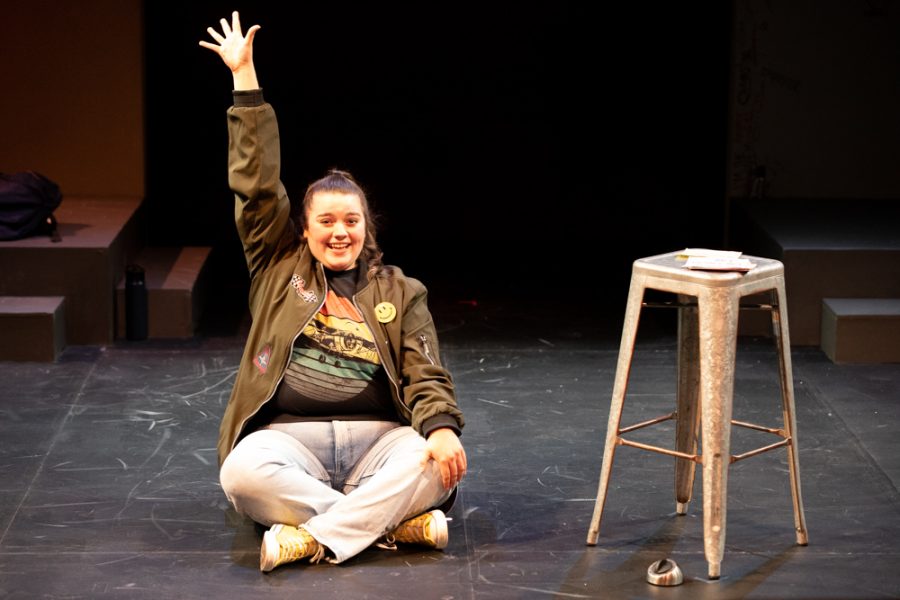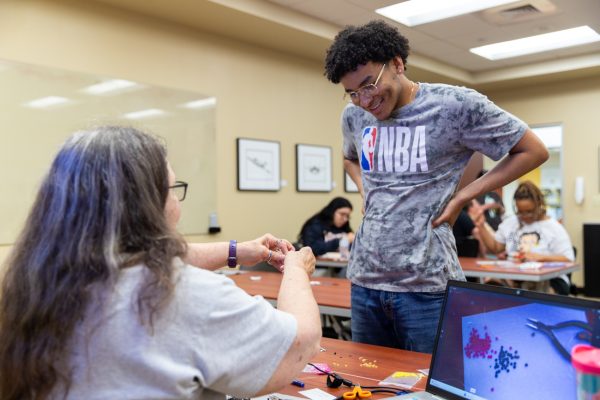Award winning play “Happy Wright” touches on the struggles of mental illness for college students
Happy Wright, played by Renae Richmond, asks the audience if they like airplanes on Oct. 8 in Welsbacher Theatre. Wright has an obcession with airplanes because the day she learned about Amelia Earhart, her life changed forever.
Happy Wright, your average college student, is much more under the surface. Between battling with depression and constant panic attacks, they are just trying to make it through life.
In 1974 the Bela Kiralyfalvi National Student Playwriting Competition was created. Bela Kiralyfalvi was a theater professor and the director of the school of performing arts at WSU until 2003.
This year’s winner was Straton Rushing, with a play entitled “Happy Wright.” The play he created revolves around a person, Happy, who seems to be lost in their own mind.
They find distractions in aviation, specifically Amelia Earhart, and poetry, though they can never escape the feeling of crashing.
WSU’s School of Performing Arts took on this play this year, crafting a one man show performed by two leads, Austin Hancock and Renae Richmond.
Richmond found that the process of becoming Happy was something that she felt very personal to. Her life and the lives she encountered helped her to create this character that felt happily hopeless.
The alternate actor for Happy, Hancock, had to learn to separate himself from the character to not lose himself in the role.
“We are the masters of the story,” Hancock said. “The story does not have control of us. We have control over the story itself. We have the power to make sure it does not take over.”
“Happy Wright” was performed for three nights on Oct. 6-8.
Happy reads us a story, the story of her life. The audience exists as mere figments of their imagination, living inside Happy’s head.
They go through the troubles they faced as their father left and their family members died one at a time. Their battle with alcoholism, passed down through the family, pushes them over the limit.
Happy has to overcome her issues with the past to be able to move forward. The obstacles in their way are vast and seem never ending.Their need to escape depression ultimately keeps them locked in it.
Rushing was loosely inspired by Samuel Beckett’s “Happy Days” while writing “Happy Wright,” including similar themes of anxiety and the topic of bravery.
He also felt that he wanted to create something almost opposite to Beckett’s work. He felt that women shouldn’t have to just take every beating the world had to offer and deal with it.
The alternate reality is that the main character of “Happy Days” had a child but lost her battle with suicide. Rushing wanted to know what this metaphorical child would be like and what they would go through. So the character Happy Wright was born.
“That is the original genesis of the play. It’s a weird one,” Rushing said. “I don’t know that people would have expected it to be like Samuel Beckett fan fiction.”
While going through the writing process, Rushing couldn’t picture one gender playing Happy. So the gender neutral role was created.
He felt that as long as the character was portrayed as a mentally ill college kid through clothing and makeup, the gender of the person who played the role didn’t matter.
Happy continuously finds themself asking questions and trying to figure out if it is better to keep flying or finally crash.
After the performance, Rushing asked the audience what some of the themes were that they noticed. Words such as empathy, hope, feeling stuck and isolation were thrown out.
“If we want the next generation of playwrights to actually kick ass and do really well,” Rushing said, “institutions have to invest in making new plays happen.”
Taking risks on weird shows like “Happy Wright” is exactly what Rushing thinks is necessary.
“I don’t think there is a university in the entire country that has done that the way WSU has in the last five decades,” Rushing said.
Though Happy is quirky and funny, audience members will still feel that they are watching a play about mental illness and that a gut punch is going to come. While watching the play, audiences find themselves rooting for Happy to make it through.
One unique aspect of the play is the analogy of a garage door. Happy’s mother committed suicide behind one and, consequently, Happy always had a fear of the garage door. As Happy grows they draw closer to the garage door in the background of the set as a way of facing their fears and troubles.
Director Ben Bolinger said that everything Happy does creates a college student aesthetic. If Happy was portrayed by someone older, the play would likely have a different feeling entirely.
“It would be a ripple effect of changes,” Bolinger said. “It would still be a phenomenal story and a phenomenal script.”
In the day and age of mental health acceptance, “Happy Wright” is an intriguing play that makes audiences want to know more about Happy.
“If you’re miserable you should acknowledge it,” Rushing said. “Get help to better yourself.”

Danielle Wagner was a reporter for The Sunflower. Her favorite quote is by Kristen Costello: "And one day the girl with the books became the woman writing...

Rachel Rudisill was the photo editor for The Sunflower in Fall 2022. Rudisill majored in journalism and was a staff photographer before becoming photo...












